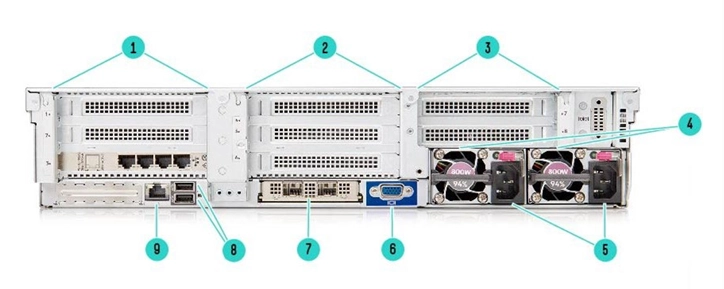What Makes the HPE ProLiant DL385 Gen10 Plus Stand Out in IoT Deployments?
Key Features Driving Its Success in IoT Applications

The HPE ProLiant DL385 Gen10 Plus is designed for strength and versatility. It fits IoT tasks well. It uses 3rd-generation AMD EPYC processors. These provide up to 128 cores. The server includes 32 DIMM slots. Memory reaches speeds of 3200 MHz. This handles large data streams common in IoT work.
It supports PCIe Gen4. This increases data transfer speeds. It also boosts network performance. These are crucial for real-time IoT needs. The server holds up to eight single-width GPUs or three double-width GPUs. This supports heavy analytics and machine learning in IoT systems.
Security stands out. The server uses Silicon Root of Trust technology. It has an AMD Secure Processor in the AMD EPYC System-on-Chip (SoC). This manages safe boot processes. It encrypts memory. It secures virtualization. These protect against cyber threats, essential for IoT environments .
How Adaptive Storage Enhances IoT Performance
The HPE ProLiant DL385 Gen10 Plus offers varied storage options. Its chassis has modular drive bays. These support up to 38 SFF or 20 LFF drives. It also allows up to 32 NVMe drives. This lets firms expand storage as IoT systems grow.
The server uses HPE Smart Array SAS/SATA Controllers or Tri-Mode Controllers. These work with SATA/SAS HDDs, SSDs, or NVMe SSDs. This mix ensures good performance for different tasks. It also controls costs.
IoT tasks need quick data access. The PCIe Gen4 interface and NVMe support speed up data flow. They reduce delays. This enables fast responses for smart factories, health monitors, or autonomous vehicles .

How Does the HPE ProLiant DL385 Gen10 Plus Compare to the Huawei FusionServer 2288H V5?
A Side-by-Side Comparison of Specifications
The HPE ProLiant DL385 Gen10 Plus and Huawei FusionServer 2288H V5 serve business needs. They differ in design. The HPE server uses two 3rd-generation AMD EPYC processors. These offer up to 128 cores. The Huawei server often uses Intel Xeon processors. This gives HPE an edge in parallel tasks like IoT analytics.
For memory, the HPE server holds up to 4TB DDR4 in 32 slots. The Huawei server matches this capacity in some setups. But HPE’s PCIe Gen4 offers faster I/O than older PCIe versions in some competitors. This improves IoT performance .
Storage Flexibility: HPE vs. Huawei FusionServer 2288H V5
Storage is a key advantage for the HPE server. It supports up to 38 SFF drives or 32 NVMe options. This allows tailored storage setups. The Huawei FusionServer 2288H V5 offers fewer high-speed storage choices, like NVMe SSDs.
The HPE server’s Tri-Mode Controllers handle SAS/SATA/NVMe drives in one system. This eases management. It also boosts storage speed. This is vital for active IoT environments .
Which Server is Better Suited for IoT Needs?
The HPE ProLiant DL385 Gen10 Plus excels in IoT tasks. It provides strong processing power. Its storage scales easily. These suit complex tasks like predictive maintenance or real-time analytics.
The Huawei FusionServer 2288H V5 suits firms preferring Intel systems. It may cost less initially. However, its limited storage growth could restrict large IoT setups. The HPE server better serves to expand systems .
Are Adaptive Storage Options the Key to Unlocking IoT Potential with HPE ProLiant DL385 Gen10 Plus?
The Role of Customizable Storage in Meeting IoT Demands
Flexible storage is critical for IoT. Countless devices produce constant data. Servers must manage varied data types.
The HPE ProLiant DL385 Gen10 Plus has modular drive bays. These allow easy storage expansion. Firms can add capacity without replacing systems. NVMe technology ensures fast read/write speeds. This supports real-time decisions in IoT work .

Real-World Applications of Adaptive Storage in IoT
Flexible storage aids IoT across sectors:
- Smart Cities: Cities rely on sensor networks. Scalable NVMe storage processes traffic or environmental data fast.
- Healthcare: Wearable health devices need quick storage. The HPE server meets this need.
- Manufacturing: Predictive maintenance systems handle large data sets. Flexible storage supports daily tasks.
- Huaying Hengtong offers IT solutions for these projects. We use servers like the HPE ProLiant DL385 Gen10 Plus. Our team ensures smooth setup and strong performance .
Why Choose Huaying Hengtong for Your IoT Hardware Solutions?
Comprehensive Product Offerings and Support
Huaying Hengtong provides tailored IT solutions. We help firms explore IoT. Our products include servers like the HPE ProLiant DL385 Gen10 Plus. It uses 3rd-generation AMD EPYC processors with up to 128 cores. It has 32 DIMM slots with memory speeds of 3200 MHz. This manages heavy IoT data loads.
The server supports PCIe Gen4. This speeds up data transfers. It is key for connected systems. Modular drive bays hold up to 38 SFF or 32 NVMe drives. This allows storage growth as IoT systems expand.
We advise clients on hardware choices. We help set up GPUs for machine learning or storage for big data. Our expertise ensures systems fit specific tasks .
Our Commitment to Ensuring Customer Satisfaction
Customer satisfaction guides Huaying Hengtong. We offer full solutions, not just products. Our team learns client needs. We suggest custom setups.
For the HPE ProLiant DL385 Gen10 Plus, we ensure easy integration. We set up security features like Silicon Root of Trust and AMD Secure Processor. These protect IoT systems from risks.
Our support lasts beyond setup. We fix technical issues. We share updates on server technology. Huaying Hengtong is a reliable partner for IT hardware needs.
FAQ
Q: Why is adaptive storage important for IoT?
A: Adaptive storage allows capacity growth as data rises. NVMe SSDs ensure strong performance for IoT tasks.
Q: What makes AMD EPYC processors advantageous for servers?
A: AMD EPYC processors provide many cores. They offer security features like memory encryption. These suit IoT analytics and machine learning.
Q: Is this server suitable for small-scale businesses?
A: Yes. Its modular design allows customization. This fits small firms planning to expand.
Q: What are the key advantages of using high-core processors in servers?
A: High-core processors handle parallel tasks. They support IoT analytics and machine learning well.
Q: How does modular storage benefit IoT deployments?
A: Modular storage allows easy scaling. It supports varied storage types like NVMe SSDs. This ensures good performance.
Q: Why is secure boot important for servers used in IoT environments?
A: Secure boot runs only trusted firmware. It guards against attacks that could harm connected devices.











